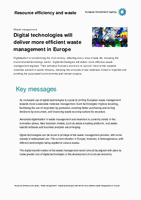
Digitalisation is transforming the 21st century, affecting every area of daily life, including the environmental technology sector. Digital technologies will deliver more effective waste management regimes. They will allow Europe’s economy to recover more of the valuable materials present in waste streams, reducing the amounts of raw materials mined or imported and avoiding the associated environmental and climate impacts.

It is becoming increasingly clear that the complex and interrelated challenges of climate change, environmental degradation and rising inequality will not be solved without a fundamental transformation of our societies. Far-reaching changes are needed to our technologies and infrastructures, cultures and lifestyles, as well as adaptations to the corresponding governance and institutional frameworks. Around the world, these important system innovations are converging in cities.

The circular economy has become a priority policy topic in Europe (EC, 2015, 2020) and is a key objective of the European Green Deal. There is increasing interest in the potential for altering traditional business models to enable materials and products to be reused and remain in the economy for as long as possible — as opposed to being used once and then discarded. This briefing presents an analytical framework, identifying actions that can be taken to implement circular business models effectively.

Plastic-based — or ‘synthetic’— textiles are woven into our daily lives in Europe. They are in the clothes we wear, the towels we use and the bed sheets we sleep in. They are in the carpets, curtains and cushions we decorate our homes and offices with. And they are in safety belts, and car tyres, workwear and sportswear. Synthetic textile fibres are produced from fossil fuel resources, such as oil and natural gas. Their production, consumption and related waste handling generate greenhouse gas emissions, use non-renewable resources and can release microplastics. This briefing provides an overview of the synthetic textile economy in Europe, analyses environmental and climate impacts, and highlights the potential for developing a circular economy value chain.

Protecting ecosystems and biodiversity are key policy targets in the EU’s biodiversity strategy for 2030 and the European Green Deal. EU and national policymaking require approaches to be developed to measure the extent and condition of ecosystems to improve their management. This briefing presents the EEA’s work on ecosystem extent accounts and pilot ecosystem condition accounts in the EU INCA project. Examples illustrate the potential use of ecosystem accounting results to design measures to protect and restore European ecosystems, e.g. in implementing the EU biodiversity strategy for 2030.
Document Actions
Share with others